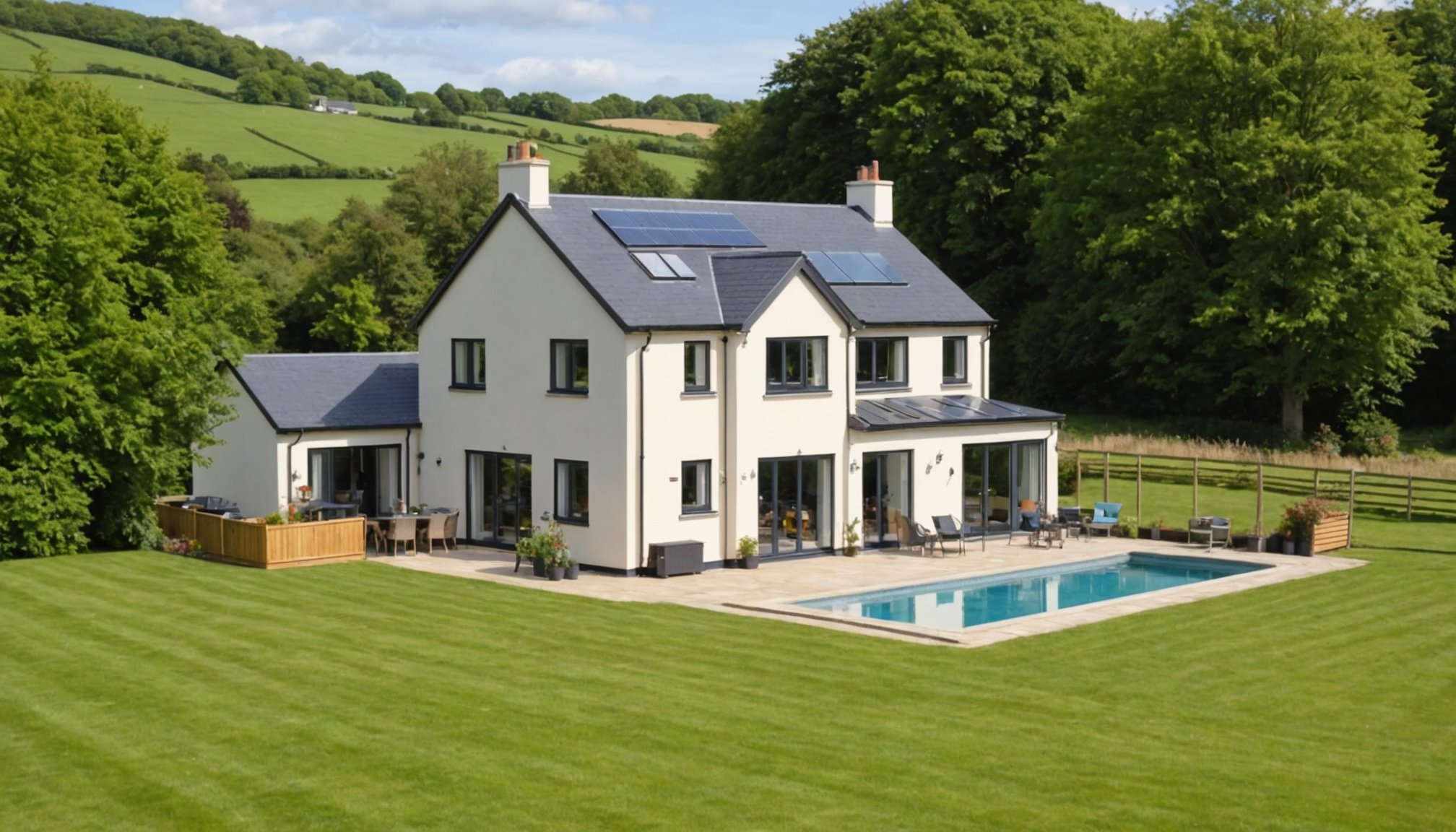Overview of Geothermal Heating Systems
Geothermal heating systems harness the renewable energy from beneath the Earth’s surface to provide an efficient heat source for homes. These systems function by circulating a fluid through underground pipes, absorbing the Earth’s natural heat, and transferring it indoors. This process makes them highly efficient, as the ground maintains a relatively constant temperature throughout the year.
One of the primary benefits of geothermal heating systems, especially in rural homes, is their ability to drastically reduce utility bills due to their reliance on renewable energy. Besides being cost-effective, geothermal systems also offer environmental advantages by significantly lowering greenhouse gas emissions compared to traditional fossil fuel-based systems.
This might interest you : Top Plant Choices for a Buzz-Worthy Pollinator Garden in Urban UK Settings
Another noteworthy benefit is the minimal maintenance requirement, making them a durable and hassle-free option for long-term use. Additionally, in regions with harsh climates, geothermal systems provide consistent heating regardless of external weather conditions.
Geothermal energy is a continuously accessible renewable resource, ensuring that Earth’s natural thermal energy is not depleted over time. This sustainable approach not only supports ecological balance but also contributes to reducing the carbon footprint of households. Consequently, investing in geothermal heating systems aligns with environmentally conscious lifestyle choices.
Also to discover : Step-by-Step Guide: Securing Approval for Exterior Painting of UK Listed Buildings
Step-by-Step Installation Guide
Installing a geothermal system can be rewarding, offering long-term savings and environmental benefits. Understanding the installation process is vital for both professionals and DIY enthusiasts. Before beginning, it is crucial to ensure preparation of the site is complete. This includes conducting a thorough site assessment to determine the soil type, available space, and underground utilities.
Preparing Your Site
The first step involves site preparation, which requires examining the ground conditions for installing a ground loop system. Prospective installers should evaluate whether horizontal or vertical loops fit best for their specific site and climate. Factors such as soil composition, moisture content, and available land area play a significant role in this decision-making process.
Choosing the Right System
Selecting the appropriate geothermal system components is key to efficient functioning. Consider the size of your home, local climate, and specific heating needs. It’s essential to pick a system size that aligns with your energy requirements, ensuring optimal performance and energy savings. Consulting with a professional can provide valuable insights here.
Installation Steps
The installation begins with setting up the ground loop, followed by installing the indoor unit. Proper ground loop installation ensures adequate heat exchange, and precise installation of the indoor unit maximises system efficiency, providing consistent heating and cooling.
Permits and Regulations in the UK
Gaining installation permits for geothermal heating systems in the UK involves navigating through a series of legal requirements. Homeowners must first secure planning permission, ensuring that their proposed installation meets local council guidelines. This step is crucial, as geothermal systems may significantly alter land usage patterns.
In addition to planning permission, a Ground Source Heat Pump (GSHP) verification may be required depending on the system’s specific parameters. Homeowners should also be aware of regulations related to drilling and construction, especially in protected areas. Compliance with these regulations ensures sustainable and responsible energy use.
The process can be daunting, but numerous resources can assist. Local council offices often provide guidance on obtaining the necessary permits and understanding UK regulations. Furthermore, consulting with a knowledgeable geothermal contractor can streamline the permitting steps, ensuring all legal requisites are met prior to installation.
Accessing grants or incentives requires adhering to government-approved specifications for geothermal installation. Thus, staying informed on current regulations and maintaining open communication with regulatory bodies can simplify the installation process for UK homeowners.
Cost Estimation
Understanding the financial considerations of installing a geothermal heating system is crucial for budget planning. The geothermal system cost encompasses various components, with initial installation being a significant expense. This cost includes the groundwork for the underground loop, heat pump installation, and connecting the system to the home’s existing setup.
However, these initial costs often result in substantial long-term savings. Geothermal systems dramatically reduce energy bills due to their efficient use of renewable energy sources. It’s vital to weigh these savings against the upfront investment to appreciate the full financial picture.
Additional expenses may include routine maintenance and potential repairs, although the latter is less frequent due to the system’s durability. Considering financing options is essential, as it can make installation more accessible. In the UK, potential grants or incentives can alleviate financial burdens, further highlighting the system’s budget-friendly aspect.
Planning your budget thoughtfully, considering all associated costs, and exploring available grants can make adopting a geothermal heating system a financially viable and environmentally responsible decision. Those interested in installing such a system should analyze these financial aspects thoroughly to ensure a well-informed investment.
Advantages and Disadvantages
Geothermal heating systems present a unique blend of pros and cons that potential users should consider. The primary geothermal advantage is its remarkable energy efficiency, utilising the Earth’s stable temperatures to provide consistent heat, leading to significant reductions in energy bills. Furthermore, these systems are highly environmentally friendly, reducing reliance on fossil fuels and markedly cutting greenhouse gas emissions.
However, it’s essential to acknowledge the system disadvantages. The upfront installation cost can be daunting for many homeowners, with initial expenses much higher than conventional systems. Additionally, not all properties are suitable due to geological constraints, which may necessitate extensive site modifications.
When comparing geothermal systems with traditional heating methods, the long-term cost savings and environmental benefits generally outweigh the initial outlay, provided the installation is correctly executed and the system is appropriately sized. Homeowners face challenges in system integration and finding skilled technicians for installation and maintenance. Potential users must deliberate these factors to ensure a well-informed decision, balancing immediate financial considerations against long-term gains. Engaging with specialized contractors and participating in local energy networks can provide valuable guidance through the initial phases.
Technical Considerations
Geothermal heating systems bring numerous technical aspects that directly influence their energy performance and overall efficiency. One critical factor is correct system sizing. Properly sized systems ensure optimal heat exchange, maximizing both performance and lifespan. A system that’s too large or small can lead to inefficiencies and increased wear.
System efficiency hinges on thoughtful design and quality components. Selecting a system with high-performance heat pumps and effective ground loops is essential for consistent energy savings. Regular monitoring and adjustments can further maintain efficiency over time.
Common troubleshooting issues include fluctuating temperatures or unexpected energy usage spikes. Addressing these requires examining the fluid levels and heat pump functionality.
To sustain peak performance, keeping an eye on operational metrics like heat exchange rates and energy consumption patterns is vital. Employing digital monitoring tools or smart thermostats can provide real-time data and insights, aiding in timely interventions.
In conclusion, technical considerations ranging from system sizing to ongoing monitoring significantly impact a geothermal system’s efficiency and longevity. By focusing on these areas, homeowners can ensure their systems operate at optimal levels, leading to enhanced energy savings and reduced environmental impact.
Maintenance Tips
Proper system maintenance of geothermal heating systems plays a vital role in ensuring optimal performance and longevity. Routine tasks include checking the filters, inspecting the heat pump, and ensuring the ground loop remains undisrupted. Regularly cleaning or replacing air filters can significantly enhance airflow and system efficiency. Monitoring the heat pump for leaks or unusual noises is crucial, as these can indicate potential issues needing attention.
Signs that a geothermal system requires professional servicing include inconsistent indoor temperatures, unexplained spikes in energy consumption, or persistent noise from the heat pump. If these occur, it’s wise to consult a qualified technician to diagnose and fix underlying problems promptly.
For those inclined towards DIY maintenance, using smart thermostats or monitoring systems to track system performance can be beneficial. These tools provide insights into energy patterns and highlight areas that may need early intervention, preventing more extensive repairs.
When professional intervention is necessary, seek recommendations from local service providers familiar with geothermal systems. They can offer tailored service recommendations and ensure your system adheres to the latest standards, maintaining its efficiency and environmental benefits effectively.
Environmental Impact
Geothermal heating systems provide significant environmental benefits by utilising the Earth’s stable temperatures to meet heating needs, significantly reducing reliance on fossil fuels. This sustainable energy approach leads to a reduction in carbon emissions and greenhouse gases, culminating in a lowered carbon footprint for households adopting these systems. The geothermal method ensures that energy extracted from the Earth is not only consistent but is also continuously replenished, presenting a sustainable alternative to conventional systems reliant on non-renewable resources.
While these systems positively contribute to environmental preservation, careful consideration during installation can further bolster these advantages. Mitigating potential ecological impacts involves eco-friendly planning, including the responsible use of materials and ensuring disturbance to the natural habitat is minimized.
Homeowners are encouraged to consult with geothermal contractors who are knowledgeable about ecological considerations. These professionals can offer systems tailored to enhance environmental benefits while maintaining system performance. Engaging with local networks or associations dedicated to geothermal energy solutions can provide additional insights and support for those interested in contributing to ecological sustainability through smart energy choices.
Local Resources and Professionals
In the journey of adopting geothermal heating systems, finding qualified installation professionals is essential. Focusing on local resources can streamline the installation, offering peace of mind to homeowners. In the UK countryside, several contractors specialize in geothermal setups. These experts ensure compliance with regulations and optimal system performance, critical for benefiting from the full potential of geothermal energy.
For DIY enthusiasts eager to embark on geothermal projects, numerous resources provide invaluable support and insights. Online forums and workshops can offer guidance, sharing tips on effective installation and maintenance of geothermal systems. Engaging with these communities enhances learning and assists in addressing challenges independently.
Additionally, associations dedicated to promoting geothermal energy solutions serve as excellent knowledge bases. These networks connect enthusiasts with professionals, fostering collaborations that advance renewable energy adoption. They also advocate for eco-friendly practices, which contribute significantly to sustainable energy efforts.
For those opting for professional services, it is advisable to verify the credentials of geothermal contractors. This can be done through local industry bodies, ensuring that chosen professionals adhere to industry standards. This due diligence ensures quality installation, maximizing the environmental benefits and efficiency of geothermal systems.











